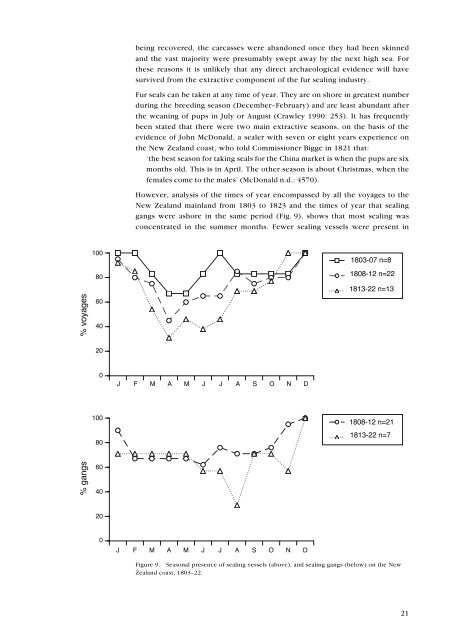The New Zealand Sealing Industry - Department of Conservation
The New Zealand Sealing Industry - Department of Conservation
The New Zealand Sealing Industry - Department of Conservation
You also want an ePaper? Increase the reach of your titles
YUMPU automatically turns print PDFs into web optimized ePapers that Google loves.
eing recovered, the carcasses were abandoned once they had been skinned<br />
and the vast majority were presumably swept away by the next high sea. For<br />
these reasons it is unlikely that any direct archaeological evidence will have<br />
survived from the extractive component <strong>of</strong> the fur sealing industry.<br />
Fur seals can be taken at any time <strong>of</strong> year. <strong>The</strong>y are on shore in greatest number<br />
during the breeding season (December–February) and are least abundant after<br />
the weaning <strong>of</strong> pups in July or August (Crawley 1990: 253). It has frequently<br />
been stated that there were two main extractive seasons, on the basis <strong>of</strong> the<br />
evidence <strong>of</strong> John McDonald, a sealer with seven or eight years experience on<br />
the <strong>New</strong> <strong>Zealand</strong> coast, who told Commissioner Bigge in 1821 that:<br />
‘the best season for taking seals for the China market is when the pups are six<br />
months old. This is in April. <strong>The</strong> other season is about Christmas, when the<br />
females come to the males’ (McDonald n.d.: 4570).<br />
However, analysis <strong>of</strong> the times <strong>of</strong> year encompassed by all the voyages to the<br />
<strong>New</strong> <strong>Zealand</strong> mainland from 1803 to 1823 and the times <strong>of</strong> year that sealing<br />
gangs were ashore in the same period (Fig. 9), shows that most sealing was<br />
concentrated in the summer months. Fewer sealing vessels were present in<br />
Figure 9. Seasonal presence <strong>of</strong> sealing vessels (above), and sealing gangs (below) on the <strong>New</strong><br />
<strong>Zealand</strong> coast, 1803–22.<br />
21
















